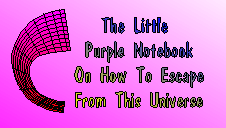
721. No Limits In The Skies
In theory, a Being is
able to perceive whatever it wants in this Universe. All it has to do is
to focus on an event in time and space.
For practical purposes, the Being restricts its focus to a rather narrow area, originally in order to enjoy the show more intensely, subsequently in order to not having to look at things it couldn't confront anymore.
A problem arises when a Being maintains a certain focus setting even after it selected a different area in time and space for experiencing.
Since a Being is twisting around time and space in its mind in an odd way, the focus model can quickly become too complicated in many situations.
For ease of understanding
the 'viewing angle' model will be used in this chapter. In this 'perspective',
the focus is always _optimal_, which means the picture is always
sharp, but the 'viewing
angle', the limited space that is being looked at, becomes restricted by
boundaries.
In the hologram model it could be compared to a sharply limited spotlight that wanders through time and space.
Time can be seen as a 'space filled with events' and because of the similarities between a Being's handling of time and space, the label 'time' will be replaced in this chapter by the label 'event space'.
The 'viewing angle model' also makes sense as a starting point for people who still belief they're nothing but a body. They have adopted the limited view of the human eye as a standard for viewing in general and since the human eye has a fixed angle of view, this fixation extends easily to their minds.
The chapters on the 'Future Spread' and the '2, 2 1/2, and 3D' views demonstrate the preparatory exercise of holding two locations in the event space (time) and the spatial dimensions _concurrently_.
The word 'concurrent' usually describes the circumstance of two events in two locations in spatial space happening at the 'same' time but here it could also be taken as two events happening at the same spatial location in _different_ times.
Since these excursions here deal with space and time, labels should be applied with extreme caution. And, needless, to say, it should always kept in mind that 'labels are labels' - 'the word is NOT the thing'.
(As a reminder, no spatial location can contain two events at the same time, a clue which becomes very interesting during the examination of the morphology of this Universe.
Since the geometry of spatial space and event space follow the same rules, the following will talk about spatial space only - the application to the event space will be left to the reader.
Warning: any enlargement
of a viewing angle is magnifying the 'power' of a Being exponentially.
With increased power, the Being can _also_ hurt itself more 'effectively'.
This is one of the reasons why it was restricting itself. A a precautionary
measure, the Being could shift to one of the 'brahmavihaara'
states (cp. 'Shifting
Attitudes') while modifying its viewing angle.
True '3D' viewing can
be achieved by 'concentrating' on two corners of an object at the same
time. This is at first glance a contradiction, of course, but the attempt
of doing so will break the fixation on 'single points' and open up the
space in between the points for viewing. Since the Being became hypnotized
many times in different contexts, '3D' viewing becomes quickly replaced
again by common 2D viewing in the
course of daily life.
(Visual artists very often have an advantage here since they are
trained to assume 2 1/2 D viewing.)
(As a side note, holding two objects in space in one's consciousness also acts as a very effective and fast exteriozation process for the above and other reasons.)
Extending the angle of view can now be achieved by selecting increasingly larger distances between the two points.
Of course, if a person is able to recognize the boundaries of its vision without any 'tricks', the person may be able to enlarge the angle of vision by just moving these boundaries outwards.
The moving of boundary is best be done gradually and slowly. The person will find itself 'hitting events', past, present, _and_ future(s), that it has been hiding from itself.
With continuous exercise, the boundaries will go towards the illusion of 'infinity'. The trick then becomes to 'look a little bit beyond the border of infinity'.
In the end, the entire view may change dramatically if a Being decides to (temporarily) drop any boundaries of perception. Gotamo called this 'entering a boundless state'.
As with 'Shifting Attitudes', a person may encounter various strange phenomena at the fringes of perception and comparable observations can be made as well. (Gotamo's 'meditation path' consists essentially of a combination of these two approaches.)
And as with 'Shifting Attitudes', the emphasis should be on the ability to _change_ the angle of view. One cannot participate in this Universe with a constantly unlimited angle (or focus).
A definition of 'Freedom' is sometimes formulated as :
Although this is a very good definition, it can (and often is) perceived as referring to static and singular viewpoints.
This limited interpretation can tempt a person to mistake its mocked-up viewpoints for 'real' viewpoints and we find sometimes references to 'viewpoints from outside this game (or this Universe').
But a viewpoint from outside this Universe cannot possibly exist. Any claim of such a viewpoint _must_ be referring to a mocked-up viewpoint. Any viewpoint related to this Universe must be IN this Universe (cp. 'The Anatta Principle').
Well, this discussion itself is, of course, border-line and quite close to the impossible and therefore better ends at this point...
Over to you!